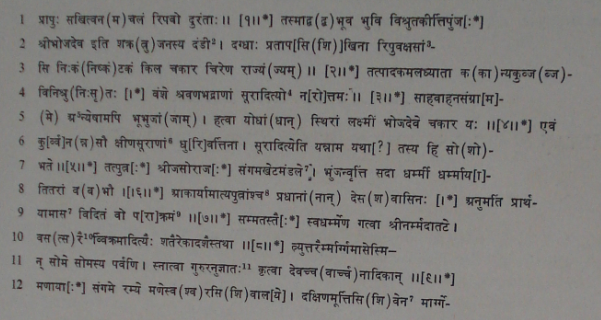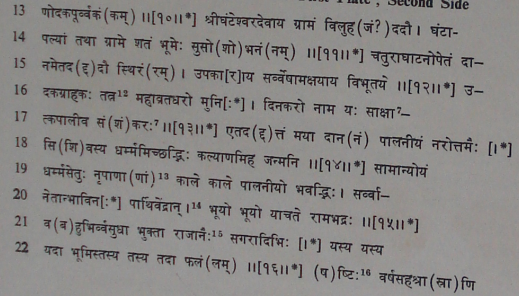| |
North
Indian Inscriptions |
| |
|
|
|
INSCRIPTIONS OF THE PARAMARAS OF MALWA
TILAKWĀḌĀ COPPER-PLATE INSCRIPTION OF THE TIME OF BHOJADEVA
TEXT
[1]
[ Metres : Verse 1 Vasantatilakā ; v. 2 Indravarjrā ; vv. 3-14, 16-21 Anushṭubh ; v.15 śālinī ].
First Plate (extant) ; First Side

First Plate ; Second Side

Second Plate
23
स्वग्गै तिष्ठति भूमिदः । म्राच्छेता(त्ता) चानुमंता च तान्येव नरके वसेत(त्)।[।१७॥*]
24 स्वर्ण्णमेक(कं) गवामेकां भूमेरप्येकम(मं)गुल(लम्)।हरन्नरकमायाति
_________________
From photographs and impressions. The plates are numbered here as they were found.
[2] It is an epithet of Yama, and here it means inflicting torture on his enemies.
[3] Read वक्षांसि, but it would not suit the metre. The first word of this quarter may better be restored to दग्ध्वा.
[4] Kudalkar : सुरादित्य ; but the medial vowel attached to the first akshara of this name is long, as to be used
in some other instances in this inscription, e.g. in 1.6, below.
[5] This vowel ought to have been dropped, as required by the rules of sandhi, but it would not suit the metre.
[6] What is probably intended is क्षीणशूराणां, in the sence of ‘one who destroyed his enemies’ ; and accordingly,
the name of the hero appears to be शूरादित्य, i.e. shining like the Sun amongst the brave.
[7] This pāda offends against the metre.
[8] Probably म्रमात्यं or म्रमात्यान् and (स्वीयान्) पुत्नान् is intended and not ‘sons of (his) ministers’, as Kudalkar
translates on p. 324. च is misplaced.
[9] Read विदितो वः पराक्रमः.
[10] This letter, if amended to वै, would remove the difficulty of the wrong use of the plural number here.
[11] Restore to गुरुभिरनुज्ञातः, but this would offend against the metre.
[12] Read -ग्राहकस्तत्र.
[13] Read धर्म्मसेतुर्नृ पाणां.
[14] Thus punctuation mark is redundant.
[15] Read राजभिः.
[16] Read षष्टिर्वर्ष or षष्टिं वर्ष or From photographs and impressions. The plates are numbered here as they were found.
|
\D7
![]()
|









